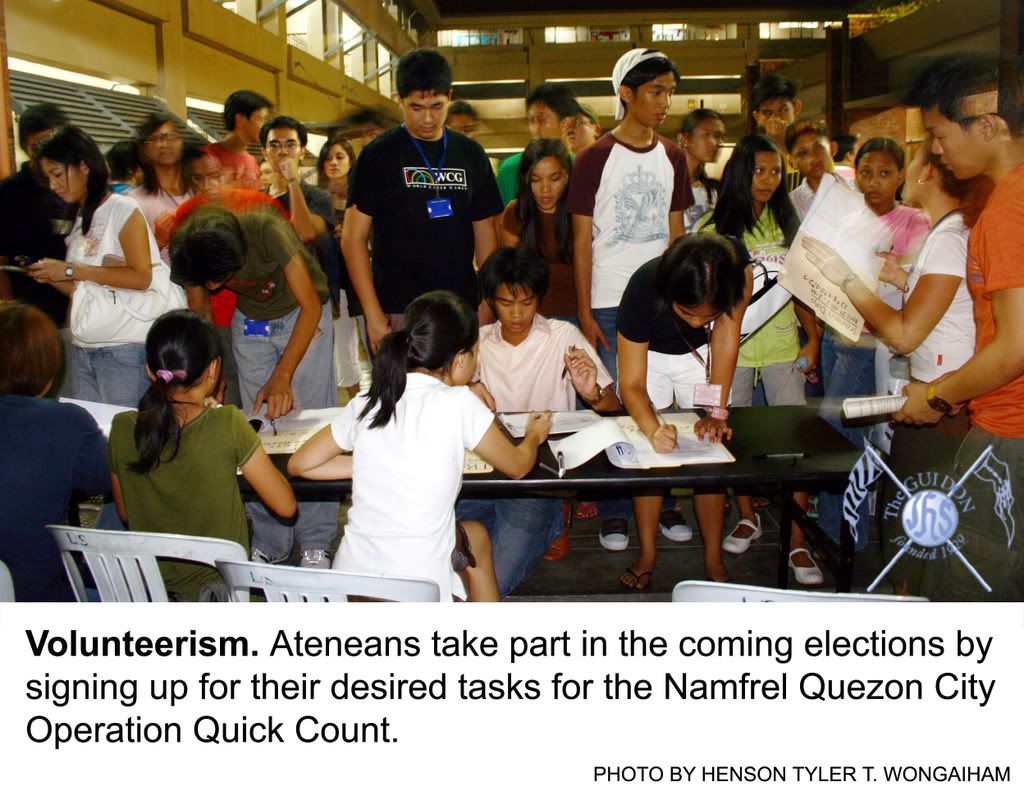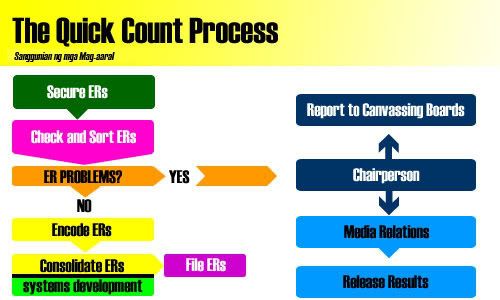 TO ORIENT volunteers and to remind them about the significance of their tasks, training sessions for Bantay Bilang, an election quick count headed by the Loyola Schools (LS), were held on April 21 and 22 at Escaler Hall.
TO ORIENT volunteers and to remind them about the significance of their tasks, training sessions for Bantay Bilang, an election quick count headed by the Loyola Schools (LS), were held on April 21 and 22 at Escaler Hall. Quick count Volunteer Training Head Aaron Palabyab (AB Comm ’07) conducted the training sessions with quick count Chairperson Boyet Dy (AB DS ’06).
Palabyab is a former 4th year Sanggunian ng mga Mag-aaral (Sanggu) executive officer for the School of Social Sciences (SOSS) Board, while Dy is a former Sanggu president.
Bantay Bilang is the National Citizens’ Movement for Free Elections (Namfrel) Operation Quick Count for the Quezon City (QC) chapter. Now with over 1,000 volunteers, this project aims to conduct a quick count of QC votes to validate the Commission on Elections (Comelec) vote count.
Over 2,000 volunteers needed
Namfrel QC Chairman Don Rapadas said that QC volunteers have an enormous task.
As of January 2007, QC has one of the country’s largest voting populations, which is 1,043,229.
For the quick count, 2,736 volunteers are needed to man the non-stop operations from May 14 to 20 at the
Each day will have six shifts, with each shift consisting of four hours. There should be 76 people per shift to maintain operations.
How the quick count works
In the training sessions, Palabyab explained the tasks that volunteers may sign up for: checkers, runners, readers, encoders, and filers.
The process begins when the administration staff receives the sixth copy of the election return (ER), the official document containing the number of registered and actual voters in a precinct, and the number of votes cast in that precinct.
At the Colayco Pavilion, the admin staff will sort and process the ERs. These will then be given to runners, who will hand the ERs to the storage area at the second floor of MVP-CSL.
Palabyab said that checkers will then make sure that the information in the ERs is complete, especially the number of registered and actual voters. The tallies of votes at the end of the ERs also have to match the stick figures.
ERs with incomplete or incorrect information will be set aside and the admin staff will contact the precinct in question to clarify the matter. Otherwise, checkers will give them to runners, who will bring them to the tabulating center in Faura Hall.
At Faura, readers will dictate the contents of the ERs to the encoder, who will input the data into a program designed to tabulate and automatically consolidate the votes.
The runners will then bring the ERs to the post-storage area at the second floor of MVP-CSL. Filers will do final checks and then file the ERs according to district.
Meanwhile, the system administrator will send the updated results to the secure site of Namfrel National every half-hour or every hour by uploading a special file with all the consolidated results.
Namfrel National will then do the final consolidation and prepare the reports for the media, political parties and candidates.
“Helpful training”
For volunteer Ma. Larissa Rachelle Espiritu (II BS Mgt), the training was helpful. “I was able to understand the different aspects of the system that I am sure will help me execute the [task] I signed up [for] properly.”
Palabyab said that only 325 volunteers attended the training sessions. The rest of the volunteers would have to go through walk-in training.
Palabyab added that volunteers must be alert, responsible, and focused. “While [the work] will be fun because [volunteers] get to work with their friends while doing something for the country, they shouldn’t forget that what they’re doing is actually serious business.”
with a report from Nikko Carlo A. Tolentino



No comments:
Post a Comment